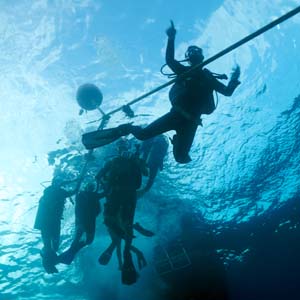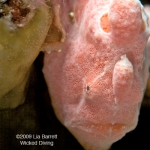Whale Sharks and Manta Rays of Thailand
Learn all about the biggest fish in the oceans
Manta Rays & Whale Sharks of Thailand – April 3, 2012
The Similan Islands are blessed! We enjoy great weather, great diving, great fun – but most of all we are able to see two of the largest and most amzing creatures on Earth! This is especially true between February and April twhen hey seem to be around at various dive sites in the region. That doesn’t mean there is a guarantee to see any of them – there are far too elusive for that!
Whale Sharks
On the Whale Shark & Manta Ray trips we will dive at sites where whale sharks and manta rays are seen most. Then we will try to “tag” the whale sharks – through pictures! We add all our picture to a worldwide database for whalesharks. All you have to do is take a picture of its side and upload it on the website and your whaleshark will get its own personal code which can be used to track them. That is, if we find one of course….We will attempt to document the Whale So keep your eyes open in the blue and cross your fingers. We will however guarantee you interesting lectures by our staff with lots of information on the life, physiology and threats of these amazing creatures.
Manta Rays
Manta Rays are massive, serene and unearthly. They glide through the currents without effort, they are sometimes 5 meters across and yet their migratory patterns are unknown? so little was known that scientists were recently surprised when a Manta Ray gave birth to a live child in an aquarium. Giant – yet passive – they eat plankton and are completely harmless to humans. None-the-less our actions still impact their lives.
As the sites where they tend to congregate are in more remote locations and deeper sites – this trip is recommended for divers with some experience. If you would like to – why not combine this trip with a 3 day Similan trip to gain confidence and experience (and enjoy the great food!).Go ahead and check availability or actually book your trip now
Learn About Manta Rays & Whale Sharks
Among things you have the opportunity to learn:
- The Life and Times of the largest fish in the world
- How to interact and treat such large creatures
- Reducing your impact on the Reef – through active training like improved bouyancy and through use of biodegradeable products
Share
How to upload your photographs to the global database, track the sightings of your whale shark and even to “adopt” your Whale Shark! Ask us for more details
Wicked Diving offers a unique opportunity to benefit the local community, improve the world around us and have a great diving vacation! We use 2% of all income to support local projects that support the local community, marine research or marine conservation (or all three!). When you dive with Wicked, you make a difference. Please read up on our various projects, and policies on the Ethical Diving page. Did you know the eggs on your trip will be from free-range, organically fed chickens? And the Honey and Jam will be from the Baan San Fan Orphanage?
Where is the Whale Shark Tour?
Aside from the vast selection of marine life we see daily on the dive sites, we hope to experience the Manta’s and Whale Sharks – so we have chosen several specific sites where they are most frequently seen. With our friends in the diving community and the network of dive baot captains – we will knwo where the most recent sightings have happened – so our itinerary is totally open to change! We hope you understand! Just a few of the reefs we will visit:
Richelieu Rock
One of the most famous dive sites in Thailand, Richelieu Rock is an isolated pinnacle to the east of The Surin Islands. Being known for Whale Shark sightings in Thailand is not Richelieu’s only claim to fame. Amazement awaits divers in every square meter of the dive site. From colorful soft corals to huge sea fans, sea hard corals and sea anemones- the topography here is spectacular. The diversity of small and large creatures and marine life is un-matched anywhere else in Thailand and is a favorite location for underwater photographers. Marine life spans from ghost pipe fish, frog fish, harlequin shrimp, seahorses, and rare nudi branches on the macro side of things, to cuttlefish mating, varied moray eels, octopus, chevron and giant barracuda, giant groupers, and manta rays for those looking for a possible encounter of the larger species.
Go ahead and check availability or actually book your trip now
Koh Tachai
A solitary island located 20 km north of Koh Bon, Tachai has white sandy beaches and is home to two interesting dive sites – the southern pinnacles and the eastern reef. Manta rays visit this area for feeding and circling around the submerged twin pinnacles, and some divers have seen Whale Sharks here as well, along with leopard sharks. Clearly a magnet for the “larger” marine life it’s also possible to spot jenkins rays, whitetip and blacktip reef sharks, swarms of chevron barracuda, batfish, and turtles. Exotic species like the oceanic triggerfish can also be found here.
Koh Bon
Know as a cleaning station for manta rays, there is a high chance of seeing them here, along with the Whale Shark – particularly along the western ridge and northeast outer reef. Koh Bon is an isolated granite islet northeast of the Similan Islands, and is home to many types of sharks such as leopard, whitetip, blacktip and the occasional grey reef tip sharks. Some divers have been known to see a nurse shark lying under the coral heads if they are lucky.
| Back to the Top |
The trip
There is always a divesite briefing given before every dive. Plenty of meals are served each day in between the dives and we have a minimum surface interval of 2 hours in between the dives. The choice of divesites and jump-in times always depend on the weather, surface and underwater conditions and the experience level of you – our divers! With the Widescreen TV, Hammocks and sundeck available to all guest you will always have time to relax!









